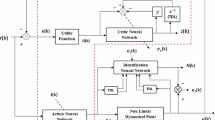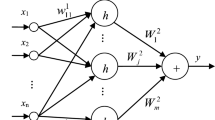Abstract
This paper presents an improved nonlinear system identification scheme using differential evolution (DE), neural network (NN) and Levenberg Marquardt algorithm (LM). With a view to achieve better convergence of NN weights optimization during the training, the DE and LM are used in a combined framework to train the NN. We present the convergence analysis of the DE and demonstrate the efficacy of the proposed improved system identification algorithm by exploiting the combined DE and LM training of the NN and suitably implementing it together with other system identification methods, namely NN and DE+NN on a number of examples including a practical case study. The identification results obtained through a series of simulation studies of these methods on different nonlinear systems demonstrate that the proposed DE and LM trained NN approach to nonlinear system identification can yield better identification results in terms of time of convergence and less identification error.
Similar content being viewed by others
Explore related subjects
Discover the latest articles and news from researchers in related subjects, suggested using machine learning.References
S. Chen, S. A. Billings, W. Luo. Orthogonal Least Squares Methods and Their Application to Non-linear System Identification. International Journal of Control, vol. 50, no. 5, pp. 1873–1896, 1989.
S. A. Billings, H. L. Wei. A New Class of Wavelet Networks for Nonlinear System Identification. IEEE Transactions on Neural Networks, vol. 16, no. 4, pp. 862–874, 2005.
K. S. Narendra, K. Parthaasarathy. Identification and Control of Dynamical Systems Using Neural Networks. IEEE Transactions on Neural Networks, vol. 1, no. 1, pp. 4–27, 1990.
R. Storn. System Design by Constraint Adaptation and Differential Evolution. IEEE Transactions on Evolutionary Computation, vol. 3, no. 1, pp. 22–34, 1999.
J. Ilonen, J. K. Kamarainen, J. Lampinen. Differential Evolution Training Algorithm for Feed Forward Neural Networks. Neural Processing Letters, vol. 17, no. 1, pp. 93–105, 2003.
O. Ludwig Jr., P. C. Gonzalez, A. C. de C. Lima. Optimization of ANN Applied to Non-linear System Identification Based in UWB. In Proceedings of the Symposium on Trends in Communications, IEEE Press, Slovakia, pp. 56–59, 2006.
C. T. Lin, C. S. G. Lee. Neural Fuzzy Systems: A Neurofuzzy Synergism to Intelligent Systems, Prentice-Hall, Inc., New Jersey, USA, 1996.
G. E.P. Box, G. M. Jenkins. Time Series Analysis, Forecasting and Control, Holden Day, San Francisco, USA, 1970.
Author information
Authors and Affiliations
Corresponding author
Additional information
Bidyadhar Subudhi received the Bachelor degree in electrical engineering from Regional Engineering College Rourkela (presently National Institute of Technology Rourkela), India, Master of technology in control & instrumentation from Indian Institute of Technology, India, in 1994, and the Ph.D. degree in control system engineering from University of Sheffield, UK, in 2003. He worked as a post doctoral research fellow in the Department of Electrical & Computer Engineering, National University of Singapore (NUS), Singapore, in 2005. Currently, he is a professor in the Department of Electrical Engineering in the National Institute of Technology, India. He is a fellow of the Institution of Engineers (India), life member of Systems Society of India and senior member of IEEE. He is serving as a technical committee member, IEEE Intelligent Control Society.
His research interests include system identification, intelligent control, control of mobile and flexible robot manipulators, and estimation of signals & systems.
Debashisha Jena received the Bachelor of electrical engineering degree from University College of Engineering, India, in 1996 and Master of technology in electrical engineering in 2004. He is currently a Ph. D. candidate in the Department of Electrical Engineering, National Institute of Technology, India. He worked as a faculty member in the National Institute of Science & Technology, India, during 2004–2007. He has been awarded a GSEP fellowship in 2008 from Canada for research in control and automation.
His research interests include evolutionary computation and system identification with application to non-linear systems.
Rights and permissions
About this article
Cite this article
Subudhi, B., Jena, D. An improved differential evolution trained neural network scheme for nonlinear system identification. Int. J. Autom. Comput. 6, 137–144 (2009). https://doi.org/10.1007/s11633-009-0137-0
Received:
Revised:
Published:
Issue Date:
DOI: https://doi.org/10.1007/s11633-009-0137-0




